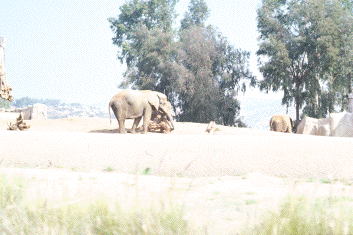Infrasonic Communication in Elephants
Infrasonic calls, because they travel great distances, provide an important mechanism
for communication and affiliation in these wide-ranging animals. By remembering
the identity of different callers, elephants can maintain contact with specific
individuals, although the social uses of individual identifications is not known.
 |
Female African elephants use "contact calls" to communicate
with other elephants in their bands (usually a family group). These infrasonic
calls, with a frequency of about 21 Hz and a normal duration of 4-5 seconds,
carry for long distances (several kilometers), and help elephants to determine
the location of other indivduals. Calls vary among individual elephants,
so that others respond differently to familiar calls than to unfamiliar
calls. Perhaps elephants can recognize the identity of the caller.
African elephants have a social structure best described as fluid; animals
move freely over wide areas, sometimes affiliating with other animals.
Female members of a family tend to stay together, and of course their
juveniles travel with them. These female-centered groups may merge with
other such groups periodically. Adult males are less likely to join groups.
|
McComb, K., C. Moss, S. Sayialel, and L. Baker. 2000. Unusually extensive networks
of vocal recognition in African elephants. Anim. Behav. 59:1103-1109.
Moss, C. J. and J. H. Poole. 1983. Relationships and social structure of African
elephants. In: Primate social relationships: An integrated Approach. R. A. Hinde
(ed.). Oxford:Blackwell Scientific
Poole, K., Payne, K., Langauer, W. R. Jr. and C. J. Moss. 1988. The social
contexts of some very low frequency calls of African elephants. Behav. Ecol.
Sociobiol. 22:385-392.
page 3-5
copyright ©2001 Michael D. Breed, all rights reserved